One big idea: Getting MARC and Metrorail to integrate fares, stations, and marketing systems, using London Overground as an example
MARC is the railroad commuter system for Maryland. It's based on historical services offered by B&O (Brunswick and Camden Lines) and the Pennsylvania Railroad (the Penn Line). But the service footprint is based on history and hasn't been updated much to reflect today's circumstances.
Because many of the stations are exurban, they don't have the kind of "transit oriented development" potential that many elected and appointed officials believe.
But there is enough service there to serve as the foundation for a wider system. Dan Malouff, who grew up in Montgomery County, and is now a planner and has been the photographer and writer behind BeyondDC for 15 years or more, laid out a vision for this which I glommed onto about 10 years ago.
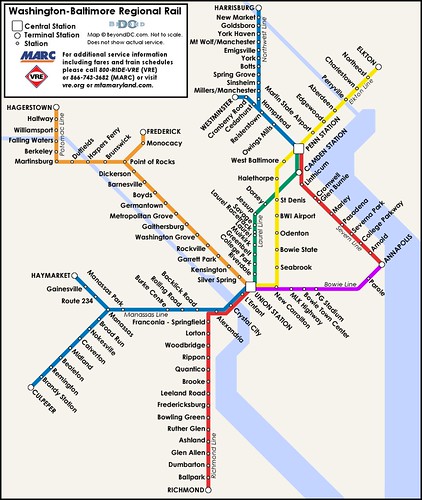
His map doesn't show railroad service to Charles County, Maryland because at the time the State was looking into light rail.
It does show new service to Annapolis from both Baltimore and Washington, and to Central Maryland and Pennsylvania (the old Maryland & Pennsylvania Railroad and North Central Railroad served these areas).
This particular map doesn't show an extension of the Penn Line to Newark, Delaware, where it would connect to SEPTA, but the potential for it is shown in a different map Dan also produced. This map also shows the possibility of service extension to Maryland's Eastern Shore from Annapolis, which ought to be popular in those precincts.
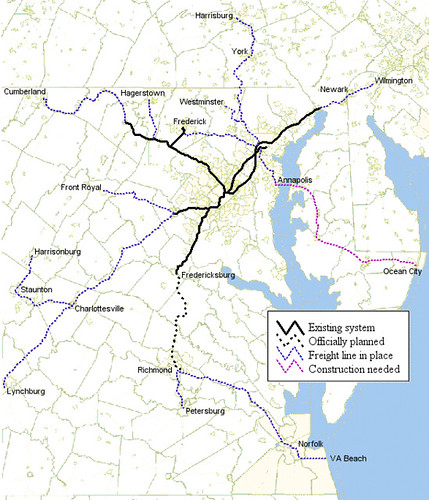
We are a long way in the Baltimore-Washington region from the integrated railroad-subway-bus systems in cities like Berlin, Hamburg, London, and Paris, although in the US, legacy services in Boston, Chicago, New York, and Philadelphia have railroads and heavy rail systems under a common organizational hierarchy.
I mention Hamburg, Germany a fair amount, because like DC, it is a city-state, although Hamburg is much bigger.
In the early 1960s, they figured out it made sense to organize transit under a common system, and over the decades, they've developed a fully integrated system that extends out of Hamburg to the adjoining states of Schleswig-Holstein and Lower Saxony, where dozens of different operators provide service that appears to be seamless to the end user. The Hamburg system includes bus, subway, railroad, and ferry service, with a common fare media system. They claim to be the first transit system to do this anywhere in the world.
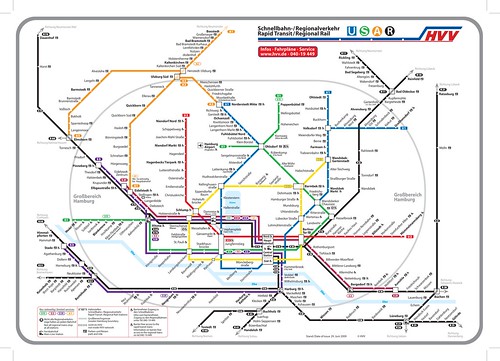
This map shows Hamburg's rail network, with ferry connections.
The Hamburg map is different from rail maps in DC or Baltimore, which show either the WMATA heavy rail system, the MTA heavy rail and light rail system in Baltimore, or the MARC services across DC, Maryland, and West Virginia, but not MARC+WMATA or MARC+MTA, like in Hamburg.
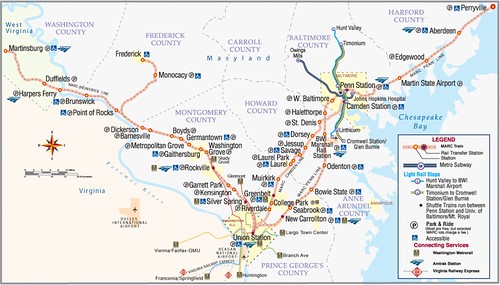
MARC system map.
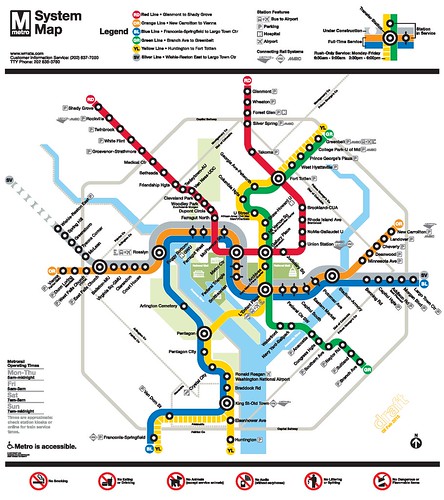
WMATA map with the Silver Line extension.
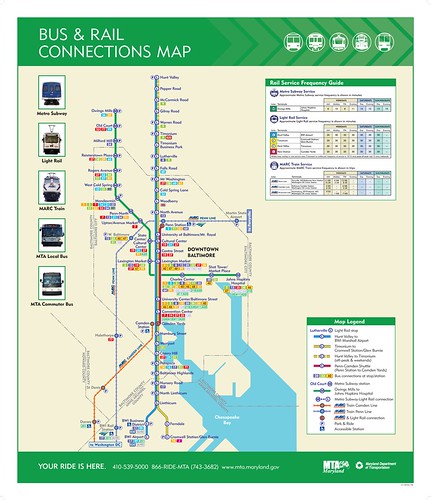
MTA transit map for Baltimore.
Similarly, in Paris, the transportation authorities have responsibility for regional railroad as well as heavy rail and tram and bus services, and they have built an incredible system of integrated transit, arguably the best in the world.
Taking a lesson from the London Underground and Paris, Transport for London has taken on marketing responsibility for a set of commuter railroad lines serving London, which it has rebranded and marketed as the London Overground, with a common visual identity, using the same fare system as for the London subway and bus systems.
This has resulted in a significant increase in ridership. Note that in New York City, Transport Politic made similar proposals for expanding LIRR and Metro-North service and utility within New York City:
-- Regional Rail for New York City - Part I
-- Regional Rail for New York City - Part II
-- New York Regional Rail: A Coda
Later, Capital published an article, "Beyond local," making the point that LIRR, Metro-North, and NJ Transit need to be shown as an integrated system (not unlike the point I make about DC-Baltimore), like Hamburg. The Capital article shows the importance of great graphics as a way to communicate a simple but complex idea.
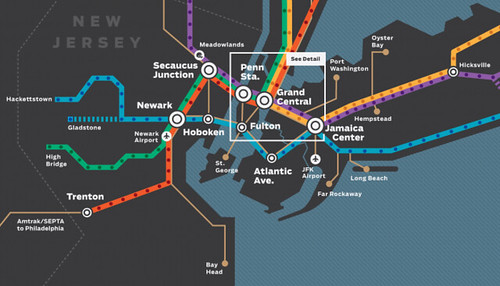
The one thing that's clear from comments in the GGW thread is that MARC needs a re-boot in marketing. Most people in the area don't really understand it. Most people in the area don't know that they can take it more cheaply to get to BWI Airport. Etc.
Maryland Transit Administration is the parent of MARC and MTA subway, light rail, and bus service in the Baltimore area, and handles Maryland's responsibilities concerning WMATA service in Maryland's DC suburbs.
MTA has already contracted with WMATA to provide an integrated fare media system for MTA, where the CharmCard is basically a branded SmarTrip card, and users of either card can use both systems. (Note that in the Puget Sound/Seattle region, the ORCA transit fare card can be used on light rail, railroad, bus, and ferry systems, although I've never ridden Sounder, and therefore never used the ORCA card on it.)
Why not consider a London Overground approach for rebranding MARC and integrating fare media systems?
This could be a first step towards my proposal for merging MARC and VRE into one service for DC, Maryland, Virginia, and West Virginia, with service also to parts of Pennsylvania and Delaware. DC would have to buy into the system--right now we don't pay into it.
London's Overground. London is more akin to New York in that the services are offered by a variety of operators, whereas in Paris and Berlin and Montreal and Toronto there is one primary railroad passenger provider, and there are multiple stations throughout the city.
_south_entrance_April2010.jpg)
Image of the Shadwell station from Wikipedia. Note how the logo identifying the Overground is a derivation of the roundel logo of the Underground.
The "Overground" is a service integration and branding program by Transport for London that focused on reconfiguring surface railroad passenger service in a manner that operates comparable to "the Tube," the Underground subway system.
Another comparable example for London Overground would be the S-Bahn system providing suburban commuter railroad services in most major German cities.
The payment system has been integrated into the Oyster card transit fare payment system, using the transit system's zone payment system. From "London Calling" in Mass Transit Magazine:
The London Overground is an urban and suburban rail network that was established in 2007. The six lines cover 53.4 miles and has 83 stations. Though a TfL-branded service, the Overground is part of the National Rail network, operated by London Overground Rail Operations (LOROL). TfL sets fares, procures rolling stock and determines service levels.
“The Overground was originally two or three lines which are orbital rather than radial so they go around London in the suburbs,” Hendy explained. “We were originally given them I think really because nobody knew what to do with them.
“So we did up the stations, we have new trains and we’ve had an enormous upsurge in patronage.” To the extent that they’ve had to extend the length of the train to accommodate ridership. He said they’ve proved that part of the national railway network could be turned into a good urban railway by applying metro principals to it: very frequent train service, attractive stations and new trains.-- "London's new train set," London Overground brochure
As service improved so did ridership. By 2011, usage increased by almost 300%, from 33 million to 120 million (("In the loop: How one railway line helped change the way Londoners commute," Economist), although there were some line extensions that also boosted usage.
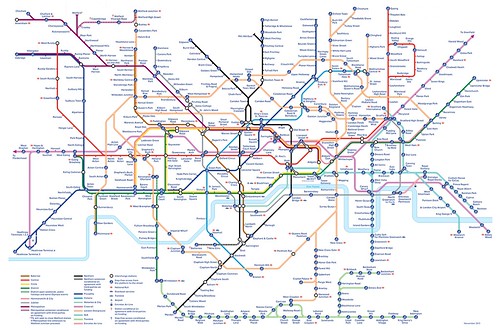
London transit map with subway and London Overground railroad services as of 2015. Granted, it's quite complicated.
Interestingly, property values have increased significantly as transit service improved, for many of the areas served by the London Overground, compared to predecessor railroad services.
Again, Transport Politic had an article proposing a similar kind of idea, how the Long Island Railroad could operate as more of a local service as it travels through Queens--the service is focused more on bringing commuters from Long Island to the city and not so much on providing "transit" equivalent service within the city. See "Expanding Transit Access to Southeast Queens."
Metrorail+MARC
Well to be honest, it's mostly about maps and fare media systems. MARC can reboot its marketing on its own. (WMATA's marketing isn't that great, but its maps are top-notch.)
Integrating the maps. A first step could be doing new transit maps for Baltimore and DC that integrate railroad service with local premium transit services. It's something I've been meaning to depict for the DC area, if I can find a good graphic designer willing to do it. (Although I'm about to take some InDesign classes...)
Integrating fare media systems. The SmarTrip card is already used by MTA for local service in Baltimore, but is branded as the CharmCard. How about adding railroad services to the mix?
WMATA has contracted to use the Canadian PRESTO fare media system. The newest version is slowly being rolled out in Greater Toronto, and like the ORCA card, will allow payment for Go Transit rail and bus, the special railroad service between Downtown Toronto and Pearson Airport, the TTC subway, streetcars, and light rail in Toronto, and local bus services across the metropolitan area.
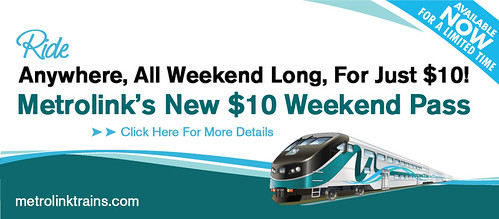
Metrollink marketing promotion, Southern California.
Stations, signage, wayfinding and transit wayfinding systems. Stations where railroad and subway services inter-connect need overhauls and significant marketing upgrades. For example, Union Station is a perfect opportunity to create seamless transit information services and marketing programs.
-- "Union Station Intermodal Transportation meeting," 2008
-- "More on Union Station DC and the need for innovative master planning," 2011
Especially if my proposal for a streetcar service for the National Mall (more on this in a day or two) and visitor service system were to come together.
-- "A National Mall-focused heritage (replica) streetcar service to serve visitors is a way bigger idea than a parking garage under the Mall"
Better MARC service, using London Overground as a model
Rebooting the brand. Well, I like my RACER proposal, which stands for Railroad Authority of the Chesapeake Region, and allows for the exchange of an identity that unites Maryland and Virginia rather than dividing it. Ideally, this presupposes that VRE and MARC merge. But there is no reason that MARC couldn't rebrand as RACER now, and work with VRE.
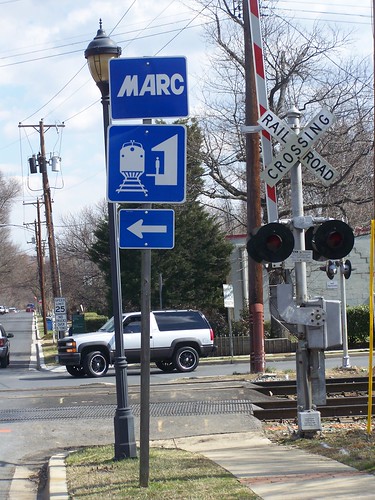 Marketing. I know about MARC because I lived by Union Station. But other than some signage on the roads, how do people to find out about it?
Marketing. I know about MARC because I lived by Union Station. But other than some signage on the roads, how do people to find out about it?Caltrain and Metrolink in California are particularly good at marketing and promotion and could teach East Coast systems a lot about marketing, although MTA in Greater NYC does a pretty good job too, given its financial constraints.
(FWIW, MTA does do outreach for local transit in Baltimore, exhibiting at festivals, etc.)
Adding reverse commuter service from DC to Germantown/Frederick. Historically, there wasn't reverse commuting service on the Brunswick Line, because in those days, cities like Rockville, Gaithersburg, and Germantown weren't significant business districts. Now, transportation demand management planning means it makes sense, especially with a new infill station for the White Flint (I mean Pike) District.
But my first response, reading this Dr. Gridlock response to "What a haul: Commuter starts D.C. to Rockville trek," (Post), was "what about reverse commuting on MARC?" Of course, wrt a query like that, Dr. G deals with the here and now, not far off possibilities.
Such a service would help reduce congestion in the Rockville Pike corridor, which is a good thing. It would also help those of us in DC who think about working in Montgomery County from time to time, but are put off on the idea, because of the difficulty of commuting, especially beyond the Metrorail catchment, but also from the east side of the city, because we have to go around 3/4 of a circle to get to the western leg of the Red Line.
More stations in the city on the current service footprint. I do think there are opportunities. I have warmed to the idea put forth by Councilman Kenyan McDuffie of Ward 5 that there could be an infill station at New York Avenue and Bladensburg Road, providing rail transit service to a corridor otherwise devoid of it.
In fact there could be two stations in this area (see "Greater New York Avenue Gateway Revitalization") on the Penn Line, and maybe somehow one on the Camden Line too (there used to be service by train in the Langdon neighborhood long ago (south of Rhode Island Avenue and west of Bladensburg Road).
But service to old stations like Takoma or Brookland probably doesn't make much sense. (Brookland could as part of broader TDM programming for Catholic University, Howard University, Washington Hospital Center, a future research park--maybe--etc.)
Service expansion in the Washington region based on the BeyondDC proposals. If there were to be new service to Charles County, there could be a station or two in Southeast DC. But of course, it'd be good for Prince George's County as well, not just via a line to Charles County, but also to Annapolis. Anne Arundel County and Annapolis would be big winners as well, with railroad service to Baltimore and DC.
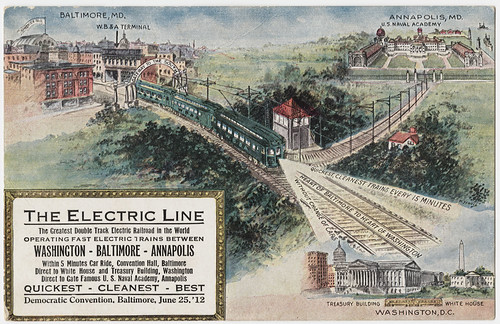
Promotion by the Washington, Baltimore, and Annapolis Electric Railroad, 1912.
MARC expansions outside of the Washington region, in north of Baltimore in Central Maryland and to Pennsylvania, and connecting "local" service on the Penn Line to Delaware are another discussion, outside the scope of this entry.
Labels: fixed rail transit service, railroads, transit marketing, transportation planning, urban design/placemaking
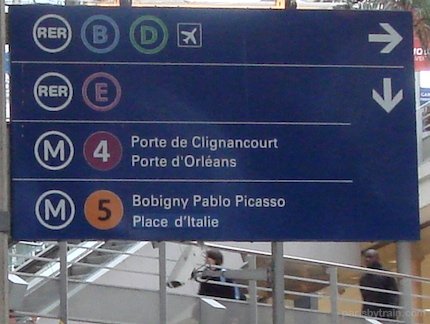




2 Comments:
Alon Levy's latest piece on making the LIRR "rapid transit"
https://pedestrianobservations.com/2018/10/20/rapid-transit-on-the-lirr/
It references:
New York City Comptroller Scott Stringer announced a proposal to improve rapid transit in Queens and the Bronx by raising frequency and reducing fares on the in-city commuter rail stations.
https://comptroller.nyc.gov/reports/expanding-access-in-one-swipe-opening-commuter-lines-to-metrocards/
Maryland MTA adds customer experience function
From Railway Age, 2/2/24
The Office of Customer Experience is now open at MDOT MTA, which operates local and commuter buses, Light Rail, Metro Subway, MARC Train service and a Mobility paratransit system. This new department is focused on “improving how riders experience transit services at each stage of their trip,” MDOT MTA reported Feb. 1. The Customer Experience Office will integrate performance management data, rider experience studies, and real-time information “with the goal of creating impactful improvements for riders,” it said.
MDOT MTA said the office has created a Customer Experience Dashboard, replacing the Performance Improvement webpage, which launched in 2019. The new dashboard will allow the public to track multiple service performance indicators, including on-time performance, ridership, service delivered, real-time information availability, and operator hiring efforts. The dashboard will be updated regularly with additional metrics based on rider feedback.
Michael Helta has been promoted to lead the department as Chief Customer Experience Officer. With more than a decade of experience at Maryland Transit Administration, he has headed the Capital Programming, Project Development, and Innovation offices. Helta recently led the implementation of the agency’s real-time passenger information system across all transit modes.
Roxana Beyranvand has also joined the team as the agency’s first Director of Rider Experience. She was most recently with Baltimore City’s Office of Innovation and Performance.
According to MDOT MTA, the Office of Customer Experience in 2024 will lead the implementation of projects to gain rider feedback, including focus groups, internal riding campaigns, experience surveys, a rider liaison program, and other initiatives, so that it can “gain a better understanding of transit riders and how to improve their experience before, during and after their ride.”
https://www.mta.maryland.gov/customer-experience-dashboard
Post a Comment
<< Home